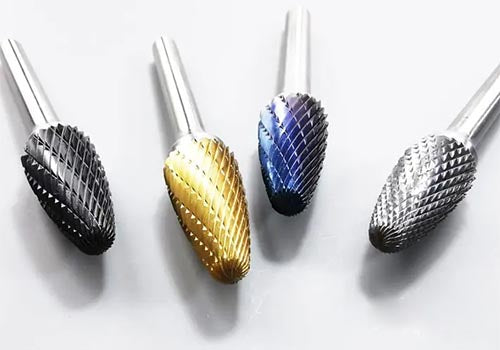
The Pros and Cons of Different Carbide Burr Coatings
Share
Carbide burrs are widely used in different industries for cutting, shaping, and grinding hard materials. These tools come in different shapes and sizes and are made from a variety of materials, including steel, tungsten carbide, and ceramic. However, the coatings used on carbide burrs play a crucial role in determining their performance and lifespan.
In this blog post, we will discuss the pros and cons of different carbide burr coatings. We will cover four types of coatings that are commonly used in the industry: Titanium Nitride (TiN), Titanium Carbon Nitride (TiCN), Aluminum Titanium Nitride (AlTiN), and Zirconium Nitride (ZrN).
Titanium Nitride (TiN)
Titanium Nitride is a popular coating for carbide burrs. It is a hard and wear-resistant coating that can extend the life of the burr. TiN coated burrs are ideal for use on hard materials such as steel, iron, and titanium. The coating is also known for its ability to reduce friction, making it easier to use the burr. However, the downside of TiN coating is that it can be brittle and prone to chipping or flaking. This can lead to reduced performance and decreased lifespan of the burr.
Titanium Carbon Nitride (TiCN)
Titanium Carbon Nitride is a combination of TiN and carbon. This coating offers improved toughness compared to TiN. TiCN-coated carbide burrs are more suitable for use on softer materials such as aluminum, brass, and copper. The coating is less prone to chipping and flaking, which makes it more durable than TiN. However, TiCN coating is less wear-resistant than TiN, which means that it may not last as long when used on harder materials.
Aluminum Titanium Nitride (AlTiN)
Aluminum Titanium Nitride is a highly wear-resistant coating that provides excellent performance on hard materials. AlTiN-coated carbide burrs can withstand high temperatures and are ideal for use on stainless steel, cast iron, and hardened steel. The coating is also resistant to oxidation, which can help extend the life of the burr. However, AlTiN coating is expensive compared to other coatings, which may make it less accessible for some users.
Zirconium Nitride (ZrN)
Zirconium Nitride coating is a relatively new coating for carbide burrs. It offers excellent wear resistance and toughness. ZrN-coated carbide burrs are suitable for use on various materials, including aluminum, stainless steel, and hardened steel. The coating is also less prone to chipping and flaking than TiN, which makes it more durable. However, ZrN coating is also expensive compared to TiN and TiCN coatings, which may limit its accessibility.
Conclusion
The choice of coating for your carbide burr depends on the application and the material you are working on. TiN coating is ideal for hard materials, TiCN coating is better for softer materials, AlTiN coating is best for high-temperature applications, while ZrN coating offers excellent wear resistance and toughness. However, the choice of coating also depends on your budget as some coatings are more expensive than others.
It is important to note that the quality of the coating and the manufacturing process can also impact the performance of the carbide burr. Therefore, it is recommended to purchase carbide burrs from reputable manufacturers that use high-quality coatings.
We hope this blog post has helped you understand the pros and cons of different carbide burr coatings. If you have any questions or comments, please feel free to leave them below.




